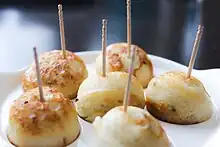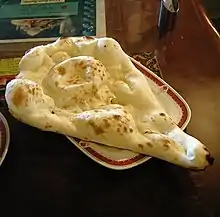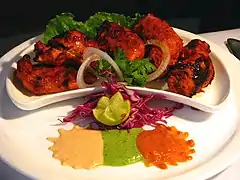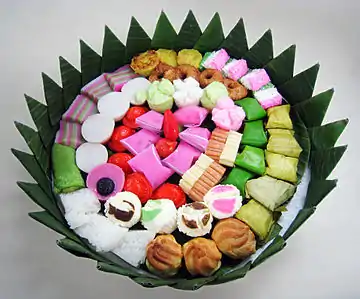 Appam | |
| Alternative names | Hoppers, Ãppa, kallappam, vellappam, palappam |
|---|---|
| Type | Pancake or griddle cake |
| Course | Breakfast or dinner |
| Associated cuisine | India, Sri Lanka |
| Main ingredients | Rice batter |
| Variations | Egg hoppers |
Appam also known as aappam; (Malayalam: അപ്പം) or āppa (Sinhala: ආප්ප) is a type of thin pancake originating from South India and Sri Lanka. It is made with fermented rice batter and coconut milk, traditionally cooked in an appachatti, a deep pan similar in shape to a wok. It is part of Kerala and Tamil cuisine found in the Indian states of Kerala and Tamil Nadu, and in Sri Lanka.[1] Appam is most frequently served for breakfast or dinner, often with a topping such as an egg.
Etymology
Appam is a Tamil word (also "aapa", "appe") and Sanskrit word ("apupa") meaning "fried dainty".[2]
History
Vir Sanghvi, an Indian journalist, quotes food historian K. T. Achaya and states that the appam is mentioned in the Tamil Sangam literature, in works like Perumpāṇāṟṟuppaṭai.[3][4][5] Achaya states that appam was well-established in ancient Tamil country as mentioned in Sangam, with poems also describing appam along with modakam being sold at street markets in ancient city of Madurai.[6][7]
“At nightfall, the sounds of conch shells cease, and shops are shut, their screens pulled down. Vendors, who sell delicate appams that are like honeycombs and modakam that are made by hand filled with coconut and sugar sweet and pulses, go to sleep”.
Appam is a close relative of dosa. Early dosas were made from rice batter and later black lentils were introduced, and since then black lentils have become an integral component of dosa.[3] The recipe of appam unlike dosa has remained unchanged for centuries.[3] One of the earliest recipes for appam can be found in the elaborately carved recipe on the walls of the Srirangam temple, made to be offered to the deity.[8][9]
Appam also has a rich history in the island nation of Sri Lanka.[10] There are multiple styles of fermenting appam, and some Jewish historians have noted that the Cochin Jews of Kerala used fresh toddy instead of yeast.[11][12]
Variations
_from_Kerala%252C_India.jpg.webp)



Idiyappam
Idiyappam (string hopper or noolputtu) is made from rice noodles curled into flat spirals. It is served for breakfast with a thin curry of fish or chicken, containing only one or two pieces of meat, a dhal (lentil) dish, and a spicy sambol or fresh chutney. Kiri hodi or sodhi, a type of coconut milk curry, is another popular accompaniment to idiyappam. String hoppers are made from steamed rice flour made into a dough with water and a little salt, and forced through a mould similar to those used for pasta to make the strings. They are cooked by steaming. Some people even sprinkle grated coconut on the rice noodles. These hoppers can be bought ready-made. In India and Sri Lanka, String Hoppers can be served as both a breakfast meal and as dinner. There are many variations to hoppers, depending on, for example, the type of flour used. This simple dish can be adapted into other foods such as string hopper biriyani, by adding scrambled eggs or vegetables.[13]
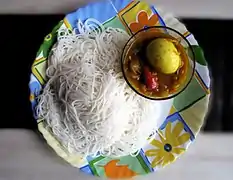
Achappam
Achappam is a deep-fried rose cookie made with rice. It is a signature Syrian Christian food.[14]
Kuzhalappam
Kuzhalappam is a typical Syrian Christian-Saint Thomas Christians dish which is a fried crisp curled up like a tube.[15]
Neyyappam
Neyyappam owes its origins to Kerala and has been a traditional offering in Hindu temples for God.[16] It is made with rice flour, jaggery and clarified butter ghee, which is the traditional method of making Nei appam. Again, the different culture and religious practices introduced variations to the dish as described in the citation above.
Unni appam is a variation in which mashed plantain is added to the batter. The batter is made out of rice flour, jaggery and plantain and is poured into a vessel called appakarai or appakaram, which has ghee heated to a high temperature. The appams take the shape of small cups and are fried until deep brown.
Pesaha appam
Pesaha appam is made by Nasrani Christians in Kerala during Pesaha (Passover). This type of appam is dipped in syrup or Pesaha Pal (Passover Coconut Milk) before being served.[17]
Vattayappam
.JPG.webp)
Vattayappam is made from rice flour, sugar, and coconut. It is an oil-free tea-time snack in a majority of households in Kerala.[18] The dish is made by steam-cooking the batter and is very similar to the bánh bò from Vietnam.
Burmese apon
Appam, called apon (အာပုံ) in Burmese, is a common street food in Burmese cuisine.[19] It is considered a delicacy of Southern Myanmar, in coastal towns like Dawei and Myeik.[20][21]
Kue apem

In Indonesia, a variant of appam is known as kue apem or kue apam. It is an Indonesian kue or traditional cake of steamed dough made of rice flour, coconut milk, yeast and palm sugar, usually served with grated coconut.[22] Indonesian households or community traditionally communally made kue apem for celebration and festivities. For example, Keraton Yogyakarta traditionally held Ngapem ceremony, where royal household communally cook kue apem (Javanese version of appam) as a part of Tingalan Jumenengan Dalem ceremony.[23] It is quite similar to kue mangkok. Just like kue putu it is derived from Indian influence on Indonesian cuisine.
See also
References
- ↑ Sankaranarayanan, A.; Amaresan, N.; Dhanasekaran, D. (6 December 2019). Fermented Food Products. CRC Press. ISBN 978-1-000-76095-8.
- ↑ The Bloomsbury Handbook of Indian Cuisine - Page 27-Colleen Taylor Sen, Sourish Bhattacharyya, Helen Saberi · 2023
- 1 2 3 Vir Sanghvi (2004). Rude Food: The Collected Food Writings of Vir Sanghvi. Penguin Books India. p. 110. ISBN 0143031392.
- ↑ Subhadra Sen Gupta (2012). "Always Ready for Appams!". Let's Go Time Travelling. Penguin UK. ISBN 978-8184756784.
- ↑ K. T. Achaya (November 2003). The Story of Our Food. Universities Press. p. 80. ISBN 81-7371-293-X.
- ↑ Food in Pathupattu Part III Maduraikanchi - Achaya, K.T. Indian Food: A Historical Companion. Oxford University Press 1994
- ↑ Champakalakshmi R. Trade, ideology and Urbanization South India 300 BC to 1300 AD. Oxford University Press India 1996.
- ↑ Gutiérrez, Andrea (2018), Jewels Set in Stone: Hindu Temple Recipes in Medieval Cōḻa Epigraphy. Religions., doi:10.3390/rel9090270
- ↑ Shoba (16 April 2015). "A Divine Treat". Open Magazine.
- ↑ Bullis; Hutton (2001). Food of Sri Lanka. Tuttle Publishing.
- ↑ Marks, Gil (2010). Encyclopedia of Jewish food. Wiley. ISBN 978-0-544-18631-6. OCLC 849738985.
- ↑ Sassoon, Essie, 1936- (14 June 2013). Spice & kosher : exotic cuisine of the Cochin Jews. Tamarind Tree Books Incorporated. ISBN 978-1-989242-11-7. OCLC 1268929164.
{{cite book}}: CS1 maint: multiple names: authors list (link) CS1 maint: numeric names: authors list (link) - ↑ Petrina Verma Sarkar (2 March 2011). "Appams - Appam Recipe - Hoppers - Hoppers Recipe". Indianfood.about.com. Archived from the original on 7 January 2016. Retrieved 21 November 2011.
- ↑ Menon, A. Sreedhara (1979). Social and cultural history of Kerala. Sterling.
- ↑ K.T. Achaya (1997). Indian Food: A Historical Companion. Oxford University Press. ISBN 0195644166.
- ↑ Dileep Padgaonkar (10 April 2010). "The appam takes on the naan". The Times of India. Archived from the original on 14 August 2013.
- ↑ Amprayil, Kuruvilla Cherian (16 March 2008). "Kerala Nazranee Pesaha Receipes [sic]". Nasrani Syrian Christians Network. Retrieved 22 August 2009.
- ↑ "Vattayappam- an oil free tea time snack - Appam - Palappam - Pesaha Appam - Kerala Cuisines - Cake - Snacks - Steamed".
- ↑ "လှည်းတန်းတစ်ဝိုက်မုန့်စားကြမယ်". Yangon Life (in Burmese). Archived from the original on 14 January 2021. Retrieved 14 January 2021.
- ↑ "ထားဝယ်ဆိုတာ လူငယ်တွေအတွက်ပါ". MDN - Myanmar DigitalNews (in Burmese). Retrieved 14 January 2021.
- ↑ "မြိတ်လို့ခေါ်တဲ့ ကျွန်တော့်ရဲ့ဇာတိမြေ | MingalaGO မြန်မာခရီးသွားလမ်းညွှန် – မြန်မာနိုင်ငံခရီးသွားဆိုင်ရာ တန်ဖိုးရှိအသုံးဝင်သော သတင်းအချက်အလက်များ". MingalaGO (in Burmese). Retrieved 14 January 2021.
- ↑ "Kue Apem Kukus" (in Indonesian). Sajian Sedap. 16 December 2010. Archived from the original on 12 July 2015. Retrieved 25 June 2015.
- ↑ "Para Puteri Sri Sultan Luwes Membuat Apem di Prosesi Ngapem - Tribun Jogja". Tribun Jogja (in Indonesian). 14 April 2018. Retrieved 2 July 2018.
